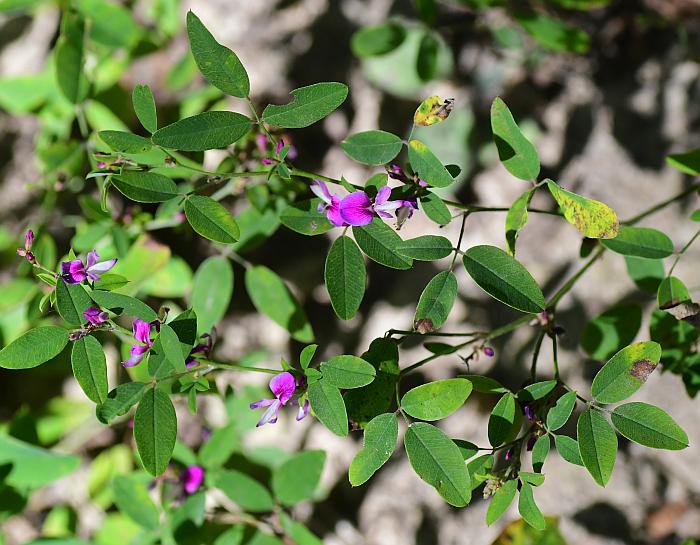Lespedeza frutescens (L.) Hornem.
Prairie Lespedeza

Native
CC = 5
CW = 5
MOC = 68
© SRTurner
Lespedeza frutescens (L.) Hornem.Prairie Lespedeza | |
 |
Native CC = 5 CW = 5 MOC = 68 |
© SRTurner |
|
Family - Fabaceae/Faboideae Habit - Perennial forb. Stem - Loosely ascending, to 60 cm, 0.8-2.2 mm in diameter near the base, often branched below the midpoint, sparsely to moderately pubescent with appressed or somewhat spreading hairs, often nearly glabrous at maturity.
Leaves - Alternate, trifoliate, petiolate, stipulate. Primary median leaves with the petiole relatively long and slender, 8-22 mm long, 0.4-0.6 mm wide, sparsely appressed- to somewhat spreading-hairy. Stipules 3-6 mm long, linear-triangular to hairlike. Leaflets 20-50 mm long, 8-30 mm wide (mostly less than 3 times as long as wide), elliptic to less commonly oblong-obovate or oblong-ovate, rounded at the base, broadly rounded or minutely notched at the tip, the midvein usually extended as a minute, sharp point at the very tip, the upper surface with minute, appressed hairs along the midvein, otherwise usually glabrous, the undersurface sparsely to moderately appressed- to slightly spreading-hairy. Axillary leaves well-developed at most nodes.
Inflorescences - Inflorescences from the axils of the upper leaves and appearing terminal, often branched (grouped into panicles) and appearing leafy, at least some of them much-exceeding the leaves. Flowers mostly 4-8 per raceme or branch, the axis not hidden by the flowers.
Flowers - Calyces with the tube 1.5-2.0 mm long, the lobes 2-3 mm long. Corollas papilionaceous, 6-9 mm long, pinkish purple to bluish purple, usually with a contrasting lighter splotch on the banner, the petals sometimes lighter colored toward the margins, the keel longer than the wings.
Fruits - Modified legumes, those from open flowers 6-9 mm long (including the stalk), the calyx covering about the lower 1/3; those from cleistogamous flowers 4-6 mm long, the calyx covering the lower 1/6-1/4. Seeds 2.5-3.0 mm long, olive green to purplish brown.
Flowering - July - October. Habitat - Bottomland to dry upland forests, upland prairie margins, glades, savannas, tops of bluffs, streambanks, fields, roadsides. Origin - Native to the U.S. Lookalikes - L. repens, L. procumbens, L. violacea. Other info. - This plant is found throughout most of Missouri, though uncommon or absent from parts of the Bootheel and the far northern reaches of the state. It also occurs throughout most of the eastern U.S., though it is uncommon in many regions. The plant is recognized by its trifoliate leaves and small, pink-purple flowers of the bean motif. It is differentiated from the lookalikes listed above by several subtle features: a growth habit which is low but not prostrate, stems with only inconspicuous, mostly appressed hairs, flowers with the keel petal longer than the wings, at least some fruits with calyces covering only the lower 1/4 or less, and hairlike stipules 3-6 mm long. The form of the inflorescence and the presence or absence of axillary secondary leaves do not seem to always be reliable characters, as single plants can often be found which show both character states. Photographs taken at LaBarque Creek Conservation Area, Jefferson County, MO, 8-28-2018, and at Don Robinson State Park, Jefferson County, MO, 9-16-2021 (SRTurner). |